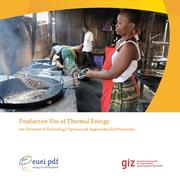Click here to register!
Productive Use of Thermal Energy
Overview
The potential benefits of promoting efficient thermal energy technologies in the productive sector, notably amongst micro and small enterprises, are frequently overlooked by policy makers and international donors. Biomass, as the most common source of thermal energy, often suffers from an unfavourable reputation as a ‘dirty’ energy source[1]. These enterprises often work in the informal sector and are frequently situated in remote areas.
Productive use of thermal energy involves a range of activities, such as cooking, drying, heating, smoking, baking, cooling and manufacturing. Biomass burning and use of solar thermal energy are already embedded in many conventional manufacturing processes in developing countries, but mainly with comparatively inefficient technologies.
An Overview of Technology Options and Approaches for Promotion
The booklet An Overview of Technology Options and Approaches for Promotion sheds light on improved thermal energy technologies for productive purposes and approaches for promoting these technologies with a focus on micro, small and medium enterprises (MSME) in the agricultural, industrial and commercial sectors. It also provides practical guidance on how to promote effectively the distribution of efficient biomass and solar thermal appliances for productive uses for energy and private sector development practitioners. Though, it does not offer ready-made ‘one size fits all’ solutions, particularly as energy needs and supply, market regulation and business environments vary greatly from country to country.
Cooking
Cooking with inefficient technologies is an environmental, health, but also a very serious economic concern for commercial kitchens. Large scale institutional stoves for canteens often require less than a quarter of the amount of firewood that cooking on a three-stone fire does. Stoves vary in design according to cooking behaviour, available fuels, and type of food that is being cooked.
But not only restaurants and canteens can profit from more efficient cooking technologies. Other businesses include beer brewing, shea butter production, distilleries, and soil sterilisation.
Case Studies:
- Kenya - Restaurants with Efficient Cookstoves
- Burkina Faso - Brewing Beer with Efficient Cookstoves
- Benin - Efficient Stoves for Producing Shea Butter
More on Efficient Cooking Energy:
Drying
Traditionally, the drying of agricultural products for storage and transportation is often done by simply spreading the produce on the ground, or placed into trays. This method is cheap and easy, but can spoil up to 70%[2] of agricultural products, especially in sub-tropical regions. In addition, the products are often of low quality, contaminated with dust and dried inconsistently. Some foods also lose nutritional value when exposed to sunlight.
Solar dryers can solve this problem by using solar energy and ventilation to keep a constant temperature throughout the drying process. This can ensure a high quality product, which can be sold off-season or further away.
Hybrid dryers run on a combination of solar energy and another fuel, often biomass or fossil fuel based.
Baking
The process of baking differs from cooking in that it requires higher temperatures to process crops into edible food. It thus takes even higher fuel inputs, making it a very costly process when using inefficient technologies. Baking with improved ovens can save a high proportion of fuel, allowing for a more economic production. Designs vary across regions, according to needs and preferences.
Case Studies:
Smoking
As with drying, smoking is a method to preserve food for storage. Traditional methods involve not much more than wooden constructions, with inefficient fuel use, whereas more efficient brick-based furnaces can save operational costs and minimize health risks. Models vary in size and material.
Case Studies:
Fish Smoking in Senegal: ENDA Énergie has been running a project on Djirnda Island in Senegal to promote improved fish smoking ovens. Traditional smoking is time intensive and dangerous, ovens are fragile and inefficient. In addition, the product is often of poor quality and low hygiene. ENDA is providing trainings and finance for women's groups and oven buiders, resulting in a much more efficient fuel use, shorter cooking times and ovens that last significantly longer.
- For more information, see ENDA Energie
Cooling
In addition to warming things, cooling is also an essential part of preservation for many food types. With many rural areas lacking connection to electricity, cooling is often limited to placing things into the shade, which is still too warm to work effectively. Once the high investment costs are overcome, solar (or biomass-fueled) coolers can transform heat into cooling energy, allowing for much better results.
Further Information
- GIZ (2013) (also available in french):
The reader’s feedback is welcomed, in order for GIZ to gain a better understanding of the topic for future successful support of productive use of thermal energy. Please do not hesitate to contact the GIZ programme “Poverty-oriented Basic Energy Services (HERA)” with your comments at hera@giz.de.




















